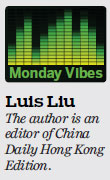Pearl offers 'Pearl of the Orient' inspiration for industry renaissance
Updated: 2018-01-15 08:09
By Luis Liu(HK Edition)
|
|||||||
Recently I happened to learn that a group of local fishermen has launched a pearl-farming business in Sai Kung; the trade had disappeared from Hong Kong's economy more than six decades ago.
The fishermen aim to make Hong Kong-cultured pearl products one of the world's top brands. The experimental plan may see the first batch of products hit the market in a year.
This would mean the Pearl of the Orient becomes literal. Maybe years later, Hong Kong pearls would join the global competition with those from Tahiti, Southeast Asia and Japan.
However, the news seems to mean more than that - "Made in Hong Kong", a term which almost disappeared from the global market for decades, is now trying to make a comeback.
The term was once a prominent symbol of guarantee for products from ships to garments. Global customers trusted it for Hong Kong people's hard work and professionalism. But with industrial transfer and upgrading, "Made in Hong Kong" was replaced by "Services from Hong Kong".

More than three decades on from the transition, people and the government of Hong Kong are desperately calling for economic diversification and re-industrialization. Obviously, knowledgeable people in the city saw the problem - a homogeneity of people's career options, a widened wealth gap and a narrowed social ladder.
The dilemma is shared by many developed economies and the guy who is "making America great again" also worries about it. But one has to recognize that those unskilled manufacturing jobs are never coming back. Re-industrialization must start with high value-added industries.
In recent years, the government has bet on innovation and technology, which is a perfect capture of the trend. High-tech is definitely an option, but don't ignore other potentials. Hong Kong's unique strengths and sound reputation would offer more inspiration.
The pearl-farming business can stand out as a good model. It is a gift from Hong Kong's natural resources and a reward for the city's long-lasting efforts in environmental protection. Nowadays it's hard to find a mega city co-existing so well with the natural world, merging the concrete jungle into a real jungle.
The business makes high-end products and will also drive a number of other high-end industries, including pearl jewelry designing, crafting, trading and the convention and exhibition industry.
Meanwhile, Hong Kong's world-renowned reputation of quality guarantee would also boost promotion of "Made in Hong Kong" worldwide.
Witnessing a booming middle-class population around the world, Hong Kong would have considerable potential to rebrand itself among high-end consumers. The city can firstly target consumers on the Chinese mainland, where the ruling Communist Party of China has highlighted the people's ever-growing needs for a better life in its guidance for future work. Anything about pursuit of a better life, anything with high quality, would have a bigger shot in the market.
Moreover, the prospect is brighter with the Mainland and Hong Kong Closer Economic Partnership Arrangement, through which a huge number of products of Hong Kong origin enjoy tariff-free treatment on the mainland.
The pearl business is just an example for something bigger. The model can be applied to other similar sectors, such as natural health products. With the growing recognition worldwide of traditional Chinese medicine and high-quality processing in Hong Kong, the city's natural products, skin care and herbal medications have huge potential to take up their share in the market.
In a broader sense, the city can apply much more of its advantages on its way to re-industrialization. In recent years rising costs on the mainland have made some garment companies relocate production lines for high-end series back to Hong Kong. The first group to return was fur garment companies.
Apart from the closing gap between workers' salaries and land rentals on the two sides, different tax regimes also offer the companies incentives. The free port of Hong Kong requires zero duty for fur fabrics from other countries. This alone can save companies as much as 20 percent on raw-material purchase.
The trend may attract more young talents to join the once-dying garment industry, create brands that represent Hong Kong fashion - a unique mixture of the East and the West - and present them to the world.
Similarly, by making good use of Hong Kong's unique features, more industries may follow suit.
Meeting the city's last-generation entrepreneurs and industrialists, I kept hearing them say: "Hong Kong is a blessed land". This is true. The only issue lies in how the people and the government of Hong Kong can translate the blessings into reality and rekindle the glory of "Made in Hong Kong".
(HK Edition 01/15/2018 page8)